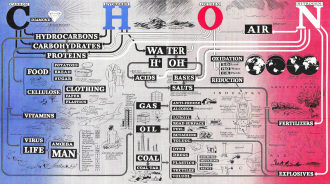|
March 23, 1942 Life
 [Table of Contents] [Table of Contents]
Wax nostalgic about and learn from the history of early
technology. See articles from Life magazine,
published 1883-1972. All copyrights hereby acknowledged.
|
My daughter dragged me to an estate
sale last weekend, and while there I found a stack of World War II era
Life magazines, many of which had some useful articles on chemistry, electronics,
and other subjects pertaining to technology being used to fight the battle against
Communism, Nazism, Socialism, and other "ism's." This 2-page spread entitled "CHON
- Four Elements Chart the Laws of All Chemistry" appeared in the March 23, 1942
issue. Today, such a diagram would be called an infographic. It explains the relationship
that Carbon, Hydrogen, Oxygen, and Nitrogen (CHON) has with all the essential products
and reactions in our everyday world. One modification to the article might be to
increase the claim that only 20 out of the known 92 elements (at the time) comprise
the makeup of the "vast bulk" of matter. While it doesn't explicitly name the 20,
some elements like lithium (batteries), gallium, and arsenic (GaAs) now have a very
large presence in the world's economy and might not have been so important in 1942.
CHON - Four Elements Chart the Laws of All Chemistry
 The poetic formula CHON embodies the four
elements most profoundly involved in the chemistry of man and his planet. One or
another or all of them are compounded in almost everyone of the substances in the
earth's surface. By themselves, they produce whole families of complex and wonderful
chemicals. With minute quantities of other elements, they elaborate into life itself.
Because there are few chemical operations and compounds, in industry or in nature,
in which they are not involved, this diagram of the interaction of Carbon, Hydrogen,
Oxygen and Nitrogen plots the broad outlines of the science of chemistry. The poetic formula CHON embodies the four
elements most profoundly involved in the chemistry of man and his planet. One or
another or all of them are compounded in almost everyone of the substances in the
earth's surface. By themselves, they produce whole families of complex and wonderful
chemicals. With minute quantities of other elements, they elaborate into life itself.
Because there are few chemical operations and compounds, in industry or in nature,
in which they are not involved, this diagram of the interaction of Carbon, Hydrogen,
Oxygen and Nitrogen plots the broad outlines of the science of chemistry.
Chemistry's basic concern is with the fact that all of the infinitely various
substances in the universe are compounded from a list of only 92 elements. The vast
bulk of matter is, in fact, made from only 20 of the elements. Elements are, like
the diamond crystal form of carbon, simple substances that cannot be broken down
into components. Elements may exist in mixtures, as do nitrogen and oxygen in air,
without losing their identity. Chemistry's interest begins when two or more elements
merge their identities in a compound and therewith become an entirely new and different
substance. Thus the two gases, oxygen and hydrogen, compound as water.
In reaction with water, the universal solvent, non-metallic and metallic elements
cleave the water molecule apart, producing acids and bases respectively. The active
factors in these two diametrically opposed compounds are the electrified fragments
of the water molecule, the positive hydrogen ion and the negative hydrogen-oxygen
ion. When an acid and a base are mixed together, the water fragments reunite and
the metal and nonmetal compound to form a salt.
Oxygen, the most active element, combines with almost all other elements in the
fundamental process called oxidation, which is familiar as fire, rusting and corrosion.
End compounds of oxidation are solid silica (SiO2), a chief constituent
of earth's crust, liquid water and the gas, carbon dioxide.
Compounds containing carbon and hydrogen make up their own family of organic
chemicals, complete with gases, liquids, solids, acids, bases and salts. Carbon
atoms have the unique property of being able to join in chains, side chains and
rings. The nature of an organic compound, therefore, depends not only on the number
of atoms of each element present in it but on the architecture of its molecule.
Within the family of organic chemicals are three complete subfamilies, the hydrocarbons,
carbohydrates and proteins. Hydrocarbons are the raw material of the coal, oil and
synthetic-chemical industries. Carbohydrates are the sugars, starches and fibers
synthesized by plants. In the family of proteins chemistry yields to biology, the
study of living things.
Posted February 9, 2022
|









